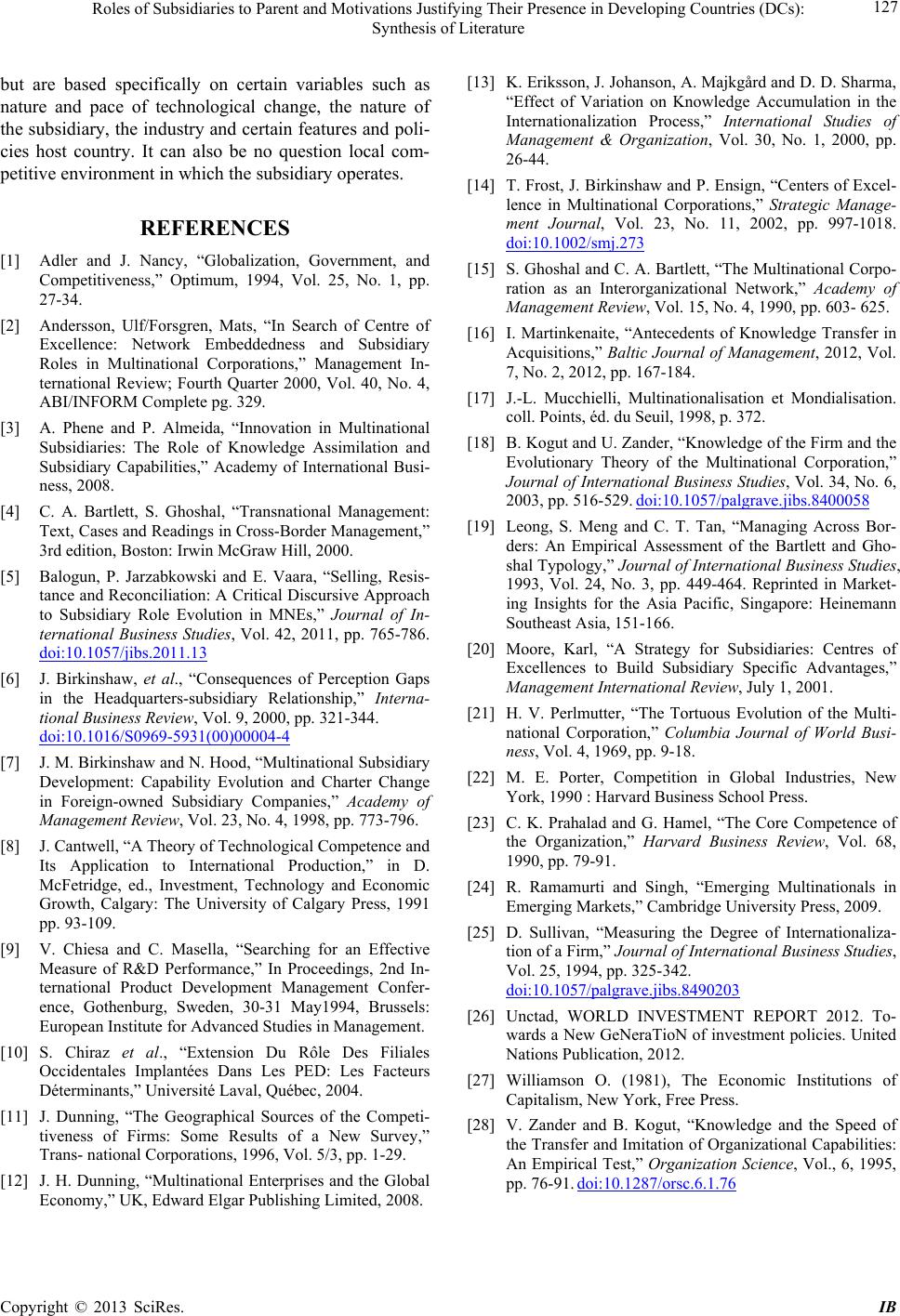
Roles of Subsidiaries to Parent and Motivations Justifying Their Presence in Developing Countries (DCs):
Synthesis of Literature 127
but are based specifically on certain variables such as
nature and pace of technological change, the nature of
the subsidiary, the in dustry and certain features and poli-
cies host country. It can also be no question local com-
petitive environment in which the subsidiary operates.
REFERENCES
[1] Adler and J. Nancy, “Globalization, Government, and
Competitiveness,” Optimum, 1994, Vol. 25, No. 1, pp.
27-34.
[2] Andersson, Ulf/Forsgren, Mats, “In Search of Centre of
Excellence: Network Embeddedness and Subsidiary
Roles in Multinational Corporations,” Management In-
ternational Review; Fourth Quarter 2000, Vol. 40, No. 4,
ABI/INFORM Complete pg. 329.
[3] A. Phene and P. Almeida, “Innovation in Multinational
Subsidiaries: The Role of Knowledge Assimilation and
Subsidiary Capabilities,” Academy of International Busi-
ness, 2008.
[4] C. A. Bartlett, S. Ghoshal, “Transnational Management:
Text, Cases and Readings in Cross-Border Management,”
3rd edition, Boston: Irwin McGraw Hill, 2000.
[5] Balogun, P. Jarzabkowski and E. Vaara, “Selling, Resis-
tance and Reconciliation: A Critical Discursive Approach
to Subsidiary Role Evolution in MNEs,” Journal of In-
ternational Business Studies, Vol. 42, 2011, pp. 765-786.
doi:10.1057/jibs.2011.13
[6] J. Birkinshaw, et al., “Consequences of Perception Gaps
in the Headquarters-subsidiary Relationship,” Interna-
tional Business Review, Vol. 9, 2000, pp. 321-344.
doi:10.1016/S0969-5931(00)00004-4
[7] J. M. Birkinshaw and N. Hood, “Multinational Subsidiary
Development: Capability Evolution and Charter Change
in Foreign-owned Subsidiary Companies,” Academy of
Management Review, Vol. 23, No. 4, 1998, pp. 773-796.
[8] J. Cantwell, “A Theory of Technological Competence and
Its Application to International Production,” in D.
McFetridge, ed., Investment, Technology and Economic
Growth, Calgary: The University of Calgary Press, 1991
pp. 93-109.
[9] V. Chiesa and C. Masella, “Searching for an Effective
Measure of R&D Performance,” In Proceedings, 2nd In-
ternational Product Development Management Confer-
ence, Gothenburg, Sweden, 30-31 May1994, Brussels:
European Institute for Advanced Studies in Management.
[10] S. Chiraz et al., “Extension Du Rôle Des Filiales
Occidentales Implantées Dans Les PED: Les Facteurs
Déterminants,” Université Laval, Québec, 2004.
[11] J. Dunning, “The Geographical Sources of the Competi-
tiveness of Firms: Some Results of a New Survey,”
Trans- national Corporations, 1996, Vol. 5/3, pp. 1-29.
[12] J. H. Dunning, “Multinational Enterprises and the Global
Economy,” UK, Edward Elgar Publishing Limited, 2008.
[13] K. Eriksson, J. Johanson, A. Majkgård and D. D. Sharma,
“Effect of Variation on Knowledge Accumulation in the
Internationalization Process,” International Studies of
Management & Organization, Vol. 30, No. 1, 2000, pp.
26-44.
[14] T. Frost, J. Birkinshaw and P. Ensign, “Centers of Excel-
lence in Multinational Corporations,” Strategic Manage-
ment Journal, Vol. 23, No. 11, 2002, pp. 997-1018.
doi:10.1002/smj.273
[15] S. Ghoshal and C. A. Bartlett, “The Multinational Corpo-
ration as an Interorganizational Network,” Academy of
Management Review, Vol. 15, No. 4, 1990, pp. 603- 625.
[16] I. Martinkenaite, “Antecedents of Knowledge Transfer in
Acquisitions,” Baltic Journal of Management, 2012, Vol.
7, No. 2, 2012, pp. 167-184.
[17] J.-L. Mucchielli, Multinationalisation et Mondialisation.
coll. Points, éd. du Seuil, 1998, p. 372.
[18] B. Kogut and U. Zander, “Knowledge of the Firm and the
Evolutionary Theory of the Multinational Corporation,”
Journal of International Business Studies, Vol. 34, No. 6,
2003, pp. 516-529. doi:10.1057/palgrave.jibs.8400058
[19] Leong, S. Meng and C. T. Tan, “Managing Across Bor-
ders: An Empirical Assessment of the Bartlett and Gho-
shal Typology,” Journal of International Business Studies,
1993, Vol. 24, No. 3, pp. 449-464. Reprinted in Market-
ing Insights for the Asia Pacific, Singapore: Heinemann
Southeast Asia, 151-166.
[20] Moore, Karl, “A Strategy for Subsidiaries: Centres of
Excellences to Build Subsidiary Specific Advantages,”
Management International Review, July 1, 2001.
[21] H. V. Perlmutter, “The Tortuous Evolution of the Multi-
national Corporation,” Columbia Journal of World Busi-
ness, Vol. 4, 1969, pp. 9-18.
[22] M. E. Porter, Competition in Global Industries, New
York, 1990 : Harvard Business School Press.
[23] C. K. Prahalad and G. Hamel, “The Core Competence of
the Organization,” Harvard Business Review, Vol. 68,
1990, pp. 79-91.
[24] R. Ramamurti and Singh, “Emerging Multinationals in
Emerging Markets,” Cambridge University Press, 2009.
[25] D. Sullivan, “Measuring the Degree of Internationaliza-
tion of a Firm,” Journal of International Business Studies,
Vol. 25, 1994, pp. 325-342.
doi:10.1057/palgrave.jibs.8490203
[26] Unctad, WORLD INVESTMENT REPORT 2012. To-
wards a New GeNeraTioN of investment policies. United
Nations Publication, 2012.
[27] Williamson O. (1981), The Economic Institutions of
Capitalism, New York, Free Press.
[28] V. Zander and B. Kogut, “Knowledge and the Speed of
the Transfer and Imitation of Organizational Capabilities:
An Empirical Test,” Organization Science, Vol., 6, 1995,
pp. 76-91. doi:10.1287/orsc.6.1.76
Copyright © 2013 SciRes. IB